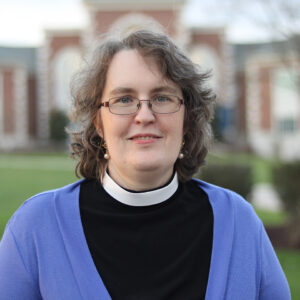Yes, Virginia, There is a Sunday After Easter
Scripture — Acts 2:14a, 22-24 (NRSV)
Peter, standing with the eleven, raised his voice and addressed the crowd, “You that are Israelites, listen to what I have to say: Jesus of Nazareth, a man attested to you by God with deeds of power, wonders, and signs that God did through him among you, as you yourselves know— this man, handed over to you according to the definite plan and foreknowledge of God, you crucified and killed by the hands of those outside the law. But God raised him up, having freed him from death, because it was impossible for him to be held in its power.”
Focus
Even as we are recovering from Holy Week’s liturgy marathon—even as we are trying to bring the message of Easter to our daily life and work—even as we doubt and wonder and pray and look for continued transformation—Jesus is with us.
Devotion
Many years ago, I sang in a large youth choir at a Presbyterian church (I was a United Methodist, but they were a pretty ecumenical bunch). Recently, in going through old files, I found some copies of sermons preached by the senior pastor of that church. That is why I can tell you that on Sunday, April 6, 1986, the Rev. Dr. Philip Queen preached a sermon called “Yes, Virginia, There is a Sunday After Easter.”
The “Yes, Virginia” bit—because we’re now almost 40 years down the road from when I heard this sermon and you may not know this story—comes from a famous editorial written in 1897 called “Yes, Virginia, There is a Santa Claus.” In that editorial, New York Sun newspaperman Francis Pharcellus Church reassured an eight-year-old named Virginia O’Hanlon that she could keep believing in Santa as the manifestation of the Christmas spirit. (We can tackle that theological problem this coming December.) When I was a kid, people used to still say “Yes, Virginia, there is a…” as a way of being emphatic about something. Maybe they still do, but I haven’t heard it recently.
Anyway, Dr. Queen’s point keyed into the way many church folks feel on the Sunday after Easter Sunday. The church has traditionally celebrated fifty days of Eastertide beginning with Easter Sunday, asking us to experience Easter joy for ten days more than we spent in Lenten contemplation. But I have to admit that even in the most liturgical of churches, the Second Sunday of Easter—this year it’s tomorrow, if you’re counting—can deserve its nickname of “Low Sunday.” Holy Week was dark and intense, the Easter Vigil was beautiful and exhausting, Easter Day was joyous and powerful, the choir is tired, the priest is tired, the altar guild is tired, everyone is tired!
During the Easter season, scriptures from Acts are usually read instead of the Old Testament lesson so that we can hear the story of the birth of the early church. On this “Low Sunday” we begin our journey in Acts very near to the beginning of the early church—with Peter’s sermon to the crowd on the day of Pentecost, interpreting to them what has been happening over the past weeks. Peter explains that Jesus was killed but that he has risen again. He relates the story of Jesus’ death, resurrection, ascension, and the coming of the Spirit to the message of the Messiah as foretold by the prophet Joel and by King David in the Psalms (Acts 2:14-36). His altar call works, and thousands of people repent and accept baptism (Acts 2:38-41).
We associate this story with the drama and celebration of Pentecost, as we should. But by placing it here, the lectionary reminds us that the events leading to such drama and prophetic outburst begin with small movements of belief here and now—on Low Sunday.
Even as we are recovering from Holy Week’s liturgy marathon—even as we are trying to bring the message of Easter to our daily life and work—even as we doubt and wonder and pray and look for continued transformation—Jesus is with us. Yes, Virginia, there is a Sunday after Easter, and another, and another, and another—because Christ has risen. The Lord has risen indeed.
Reflect
Where do you experience tiredness and doubt today?
Where do you experience joy and celebration today?
How can you live out Easter in your daily life and work?
Act
One of my very favorite Easter poems, by George Herbert, called simply “Easter,” expresses the message of Jesus’ endless presence with us. Here is a very beautiful setting of it by the famous composer Ralph Vaughn Williams. I’ve given you the words below to contemplate and pray over.
I got me flowers to strew thy way;
I got me boughs off many a tree:
But thou wast up by break of day,
And brought’st thy sweets along with thee.
The Sunne arising in the East,
Though he give light, & th’ East perfume;
If they should offer to contest
With thy arising, they presume.
Can there be any day but this,
Though many suns to shine endeavour?
We count three hundred, but we miss:
There is but one, and that one ever.
Pray
Lord, can there be any day but this? Amen.
Banner image by Yasaman Khajehali on Unsplash.
Find all Life for Leaders devotions here. Explore what the Bible has to say about work at the unique website of our partners, the Theology of Work Project’s online commentary. Reflection on today’s Life for Leaders theme can be found here: Missional Community (Acts 1:6).
Subscribe to Life for Leaders
Sign up to receive a Life for Leaders devotional each day in your inbox. It’s free to subscribe and you can unsubscribe at any time.

Jennifer Woodruff Tait
Editorial Coordinator
Jennifer Woodruff Tait (PhD, Duke University; MSLIS, University of Illinois; MDiv/MA Asbury Theological Seminary) is the copyeditor of and frequent contributor to Life for Leaders. She is also senior editor of


